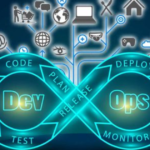Welcome to the world of DevOps, a revolutionary approach to software development that’s changing the game for tech teams and organizations worldwide! In this post, we’ll delve into the fascinating realm of DevOps, exploring its definition, history, and significance. Whether you’re a seasoned pro or a curious newcomer, this journey will equip you with the essential knowledge to harness the power of DevOps.
DevOps (Development + Operations) is a set of practices that combines software development (Dev) and IT operations (Ops) to streamline the entire software lifecycle. It’s a cultural shift that emphasizes collaboration, automation, and continuous improvement to deliver high-quality software faster and more reliably.
A Brief History of DevOps
The concept of DevOps emerged in the late 2000s as a response to the growing need for faster and more reliable software delivery. The term was first coined by Patrick Debois in 2009, and since then, it has evolved into a global movement. DevOps draws inspiration from Agile development, Lean manufacturing, and the Theory of Constraints, blending these philosophies to create a unique approach to software development.
The Benefits of DevOps
By adopting DevOps practices, organizations can:
- Improve Efficiency: Streamline processes and reduce waste
- Reduce Errors: Catch bugs and defects early in the development cycle
- Faster Deployment: Get software to market faster and more reliably
- Enhance Collaboration: Foster a culture of trust and communication
- Increase Customer Satisfaction: Deliver high-quality software that meets customer needs
DevOps Matters
In today’s fast-paced digital landscape, software development is no longer a linear process. DevOps addresses the need for speed, agility, and quality by breaking down silos and fostering collaboration between development and operations teams. By adopting DevOps practices, organizations can:
- Reduce time-to-market
- Improve software quality
- Enhance customer satisfaction
- Increase team productivity
- Reduce costs
Essential DevOps Tools
DevOps is all about leveraging the right tools to streamline your workflow. Here are the essential tools you need to get started:
Version Control Systems
- Git: The most popular version control system, Git allows you to track changes and collaborate with your team.
- SVN: Subversion is another popular version control system that helps you manage your codebase.
Continuous Integration Tools
- Jenkins: An open-source automation server, Jenkins helps you build, test, and deploy software.
- Travis CI: A hosted continuous integration service, Travis CI automates your testing and deployment process.
Continuous Deployment Tools
- Kubernetes: An container orchestration system, Kubernetes automates the deployment and management of containers.
- Docker: A containerization platform, Docker allows you to package your application and deploy it anywhere.
Monitoring and Logging Tools
- Nagios: A monitoring tool that helps you detect and resolve IT infrastructure problems.
- Splunk: A data analytics platform that helps you monitor and analyze your machine data.
Communication and Collaboration Tools
- Slack: A communication platform that helps your team collaborate and communicate effectively.
- JIRA: A project management tool that helps you track your projects and collaborate with your team.
DevOps Techniques
DevOps is not just about tools; it’s also about techniques. Here are some essential techniques to get you started:
Agile Methodologies
- Scrum: A framework that helps you manage and complete complex projects.
- Kanban: A visual system that helps you manage your work and improve your team’s efficiency.
Continuous Testing
- Unit testing: A testing technique that helps you test individual units of code.
- Integration testing: A testing technique that helps you test how different units of code work together.
Infrastructure as Code
- Terraform: A tool that helps you manage your infrastructure as code.
- CloudFormation: A service that helps you manage your infrastructure as code on AWS.
Continuous Monitoring
- Performance monitoring: A technique that helps you monitor your application’s performance.
- Security monitoring: A technique that helps you monitor your application’s security.
Implementing DevOps in Your Organization
Implementing DevOps in your organization requires a strategic approach. Here’s how to get started:
Getting Started
- Identify your goals and objectives: Define what you want to achieve with DevOps.
- Build a DevOps team: Assemble a team with the right skills and expertise.
Overcoming Challenges
- Cultural resistance: Encourage your team to embrace the DevOps culture.
- Tool integration: Integrate your tools to streamline your workflow.
Best Practices
- Automation: Automate repetitive tasks and processes.
- Feedback loops: Establish feedback loops to improve your workflow.
Conclusion:
In conclusion, our DevOps journey has taken us through the essentials of this revolutionary approach to software development. We’ve explored the definition and importance of DevOps, its key principles and benefits, and the essential tools and techniques needed to get started. From version control systems like Git and SVN to continuous integration tools like Jenkins and Travis CI, and from agile methodologies like Scrum and Kanban to infrastructure as code with Terraform and CloudFormation, we’ve covered it all. Join the DevOps revolution and watch your software development process transform like a phoenix rising from the ashes! “The future belongs to those who believe in the beauty of their dreams” – and with DevOps, your dreams of software development nirvana are just a pipeline away!



